Marine Protected Area network: 2024 report to the Scottish Parliament
A report to the Scottish Parliament on progress being made in implementing Scotland's Marine Protected Area (MPA) network.
4. The MPA network in Scotland
In total these 243 MPAs protect 37% of our seas
The MPA network supports the Scottish Government's vision for a clean, healthy, safe, productive, biologically diverse marine and coastal environment, managed to meet the long-term needs of nature and people. Scotland's MPA network also supports meeting our statutory obligations under the Marine (Scotland) Act 2010, the Marine and Coastal Access Act 2009, the Habitats Regulations and the UK Marine Strategy Regulations 2010.
There are now 233 sites in the Scottish MPA network for nature conservation purposes. These include 36 Nature Conservation MPAs (NC MPAs), 58 Special Areas of Conservation (SACs); 58 Special Protection Areas (SPAs); 65 Sites of Special Scientific Interest (SSSIs) and 16 Ramsar Sites. In addition there is one Demonstration and Research MPA (D&R MPA), eight Historic MPAs, and one OECM[4] recognised as part of the Scottish MPA network (see Annex 1 and Annex 2), making a total of 243 sites distributed across our seas (Figure 1).
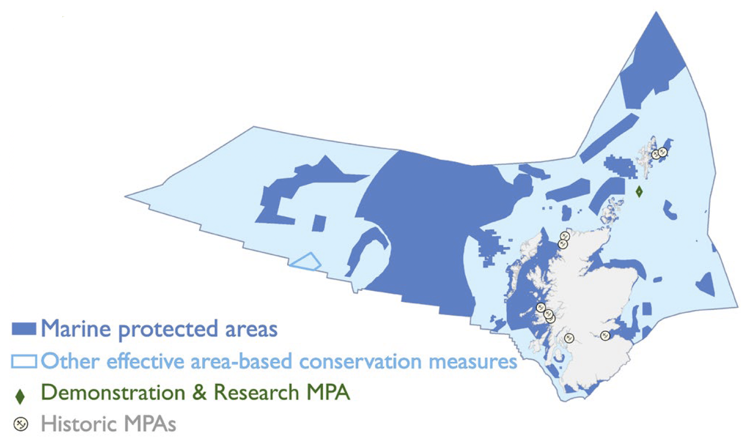
Changes to the Scottish MPA network since 2018 report
The Scottish MPA network has expanded since the last report to Parliament in 2018, and now better reflects the variety of life found in our seas. In total these 243 MPAs extend across 37% of our seas, which represents a considerable step forward from the position in 2018, when 22% of Scotland's seas were part of our MPA network (Figure 2).
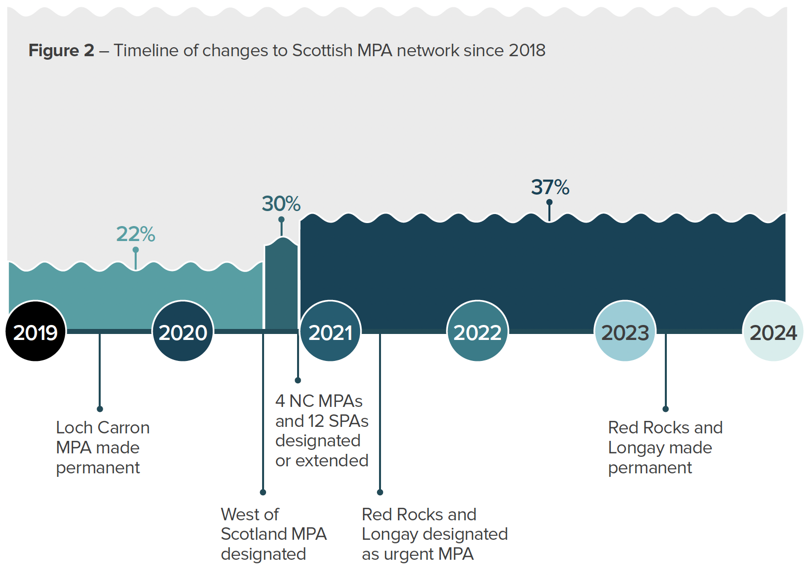
A total of 17 new MPAs have been designated to protect marine habitats, wildlife, geology and undersea landforms. Thirteen of these sites have been designated for birds and five include protections for mobile species such as minke whale, basking shark, Risso's dolphin and flapper skate. In addition, three existing sites have been extended to better protect seabed habitats and seabirds (Figure 3). (All of the new sites and changes are listed in Annex 3.)
The new sites mean that more habitats and features are included within the Scottish MPA network. From a nature conservation perspective this makes the Scottish MPA network more representative of the range of habitats and species found in our seas. The network is now considered to be coherent.
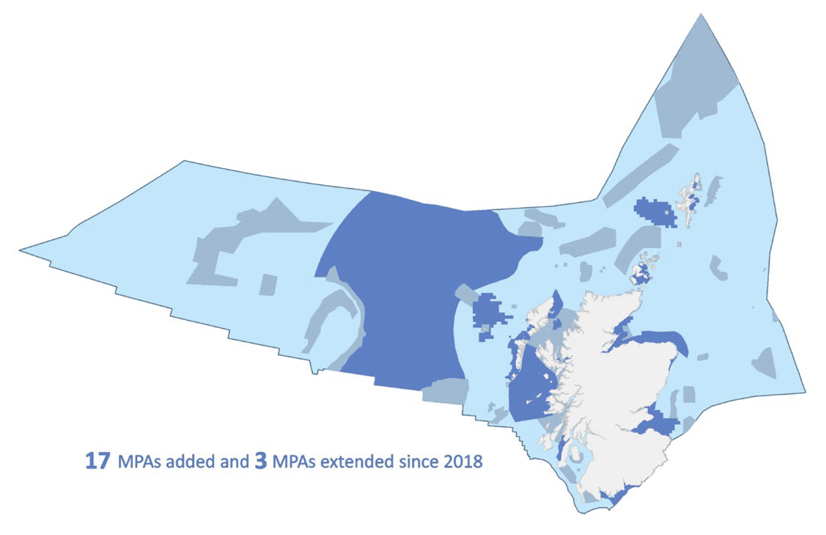
Spotlight
Spotlight: Conserving Scotland's deep sea: safeguarding a treasure-trove of marine biodiversity
Globally, deep-sea marine ecosystems offer a treasure-trove of as yet poorly understood marine biodiversity that helps to regulate the global climate and support the provision of food from our seas. Forty percent of the UK's marine area is classed as deep-sea and the majority of this falls in Scotland. Much of the marine biodiversity found in Scotland's deep waters is classed as highly
vulnerable to the impacts of pressures associated with human activities. Spectacular examples of branched cold-water corals and magnificent fields of deep-water sponge communities are in peril if we do not act to safeguard these examples and many more like it from impact.
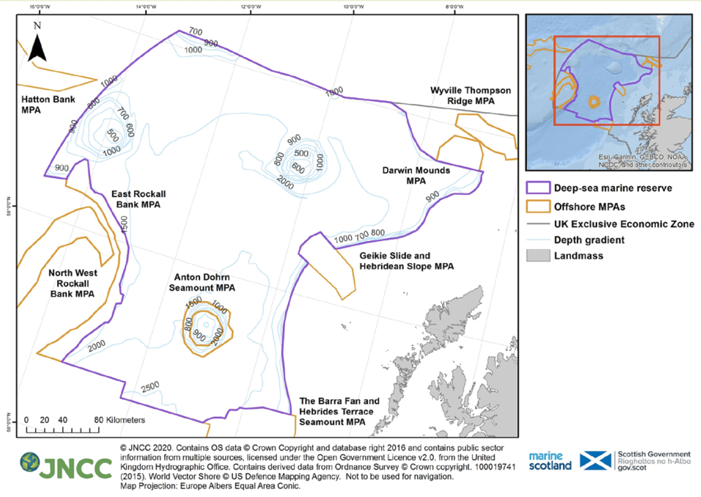
In 2020, Scotland's deep-sea marine reserve (known as the West of Scotland MPA) was designated (Figure 4). The MPA is greater in size than the combined landmass of both Scotland and Wales, coming in at over 100,000 km2. With a depth range of 400 m to just over 2,500 m at its deepest, the MPA encompasses the steep gradient of the continental slope, down into the sediment plains of the Rockall Trough. Rising up from the deep are three towering seamounts; striking ancient remnants of extinct underwater volcanoes that provide a vital stepping stone for feeding and breeding activities of deep-water fish species and marine mammals.
Spotlight (continued)
Designation of West of Scotland MPA not only sets Scotland on a path to effectively safeguarding its deep-sea marine biodiversity for future generations (Figure 5), but also makes a significant contribution to the conservation of species and habitats considered to be under threat/subject
to decline right across the North-east Atlantic. This includes habitats such as coral gardens and deep-sea sponge aggregations, and species such as leafscale gulper shark, the long-lived orange roughy and Portuguese dogfish.
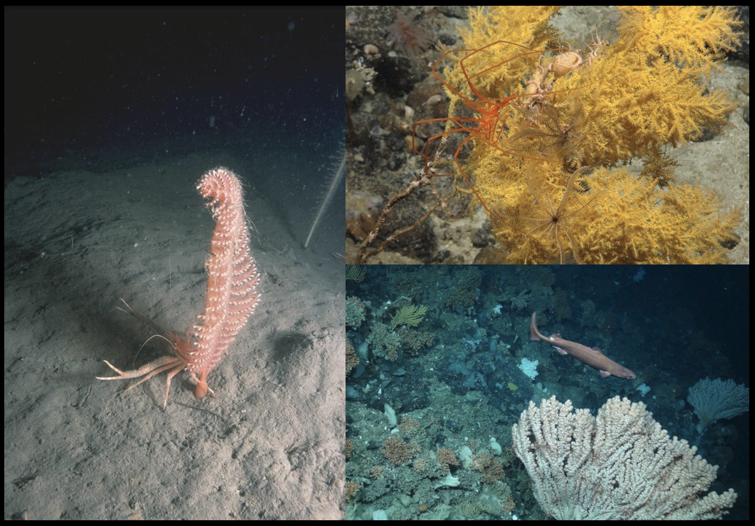
over a coral garden (Courtesy of the NERC funded Deep Links Project – Plymouth University, Oxford University, JNCC, BGS). Left: Seapen and burrowing megafauna on a burrowed mud habitat (© JNCC)
Spotlight
Fair Isle Demonstration and Research Marine Protected Area
Fair Isle is a small island within the Shetland Islands, owned by the National Trust for Scotland (NTS) and home to around 40 people. It hosts an abundance of wildlife, supports internationally important numbers of breeding seabirds and is rich in cultural heritage and community spirit. Around three quarters of the island is a Site of Special Scientific Interest (SSSI) alongside designations of a Special Area of Conservation (SAC) for certain European habitats and a Special Protection Area (SPA) for colonies of breeding seabirds. Further, the active conservation efforts of the community achieved recognition through the European Diploma Award in 1985, for which Fair Isle is one of only two sites in Scotland with this accolade.
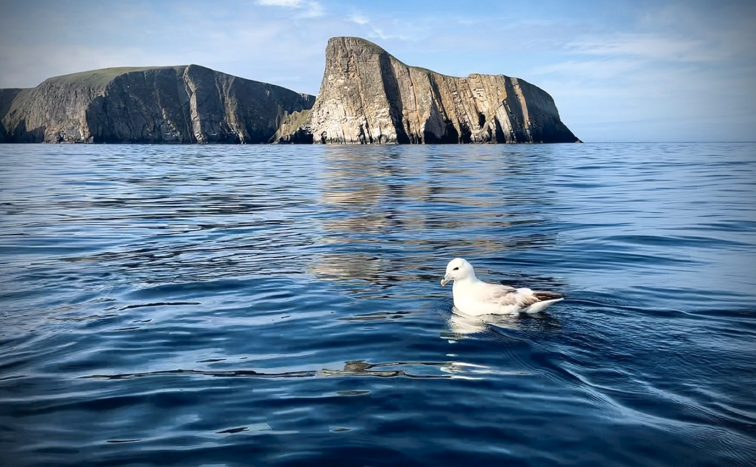
The local community began campaigning for marine protection in the 1980s and in 2011, Fair Isle Marine Environment and Tourism Initiative (FIMETI), started the proposal process for a Demonstration and Research (D&R) MPA. Designated in 2016, it is currently the only D&R MPA in Scotland, established to primarily research the relationship between healthy seas and the maintenance of a local island community. Fauna & Flora (a non-governmental organisation that supports local community conservation) provided technical and capacity support to FIMETI in this process and since designation, continues to provide ongoing bespoke support to the Fair Isle Marine Research Organisation (FIMRO), who replaced FIMETI in 2018, and the Project Officer, as well as assistance with funding.
Spotlight (continued)
The community group has engaged extensively with stakeholders and established good governance in order to work effectively. A Steering Committee was formed with clear protocols and decision-making agreements and FIMRO have actively pursued partnership working and in doing so, have effectively highlighted the importance of working collaboratively with a range of organisations who help provide for both research and financial goals. Of note, in 2024 FIMRO received substantial funding from the Shetland Islands Council, Coastal Communities Fund, to employ a Research Officer on a 3-year appointment.
In line with the site designation order, a number of priority projects and research topics were identified and are being delivered collaboratively with relevant partners. NTS lead on seabird monitoring research, such as the European shag tagging project, and have supported many other projects via funding from the NTS Players of the People's Postcode Lottery. As these studies produce information and baseline data, they evolve into further research projects and collaborative studies. A great example of the self-evolving nature of the projects is the first inshore fish survey which highlighted an abundance of flapper skate and led to the Shetland Flapper Skate tagging project and further focus on the species as important for Fair Isle.
Another valuable partnership is that of FIMRO and the University of the Highlands and Islands, Shetland. Three consecutive years of inshore fish surveys have been carried out via this collaboration and research into seabed habitats will pave the way for future research, conservation, and marine management within the Fair Isle D&R MPA.
This case study shows how D&R MPAs can provide a role for community leadership in the marine environment. As a community-led initiative, FIMRO is a member of the Coastal Communities Network, participating on the leadership council and network gatherings.
For more information on the Fair Isle D&R MPA see the FIMRO website.
Contact
Email: marine_biodiversity@gov.scot
There is a problem
Thanks for your feedback